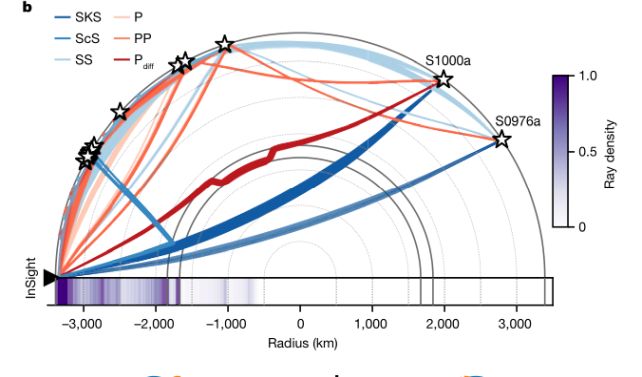Products You May Like
Mars may have a hard, dusty shell, but its interior is layered like a jawbreaker – and surprisingly squishy.
Two new papers published in the journal Nature detail the way seismic data reveals the specifics of the Martian interior. Each shows a 150 kilometer (93 miles)-thick layer of molten silicate rock at the base of the mantle envelopes Mars’ liquid iron-alloy core.
This could have implications for our understanding of Martian history – but also may have an effect on the way we interpret Mars’s seismic data, collected by the Mars InSight lander between 2019 and 2022.
Aside from Earth, Mars is the only planet with an interior structure we’ve been able to probe with seismic data. InSight, which was only operational for a few years, detected hundreds of quakes rumbling through the guts of Mars.
This revealed that Mars has a lot more going on inside than we previously thought, but an analysis of those rumbles also revealed the planet’s interior structure.

When quakes shudder through a planet, waves propagate through and reflect off different materials in different ways. A solid, rigid material is going to have a different seismic profile than an elastic, squishy one. Scientists were not only able to use seismic data to probe what’s inside Mars, but map it in detail.
That initial map was based on early data. The two new papers – led separately by geophysicist Amir Khan of ETH Zürich, and geophysicist Henri Samuel of the French National Centre for Scientific Research (CNRS), respectively – are based on a much larger dataset, including two huge seismic events thought to be the result of meteorite impacts.
Earlier measurements suggested Mars had a surprisingly large core, with a radius of about 1,830 kilometers (1,137 miles). That’s huge – over half the planetary radius of 3,390 kilometers (2,106 miles). It also meant that the core would have a relatively low density, suggesting a fair amount of lighter elements were mixed in.
The teams of both Khan and Samuel performed new measurements, and the findings of both are in excellent agreement. They found the way seismic waves bounce around Mars indicates the presence of a molten rock layer some 150 kilometers thick surrounding the core.

This, in turn, means that the core must be smaller – between 1,650 and 1,675 kilometers (1,025 and 1,040 miles) in radius. That’s in line with previous estimates of the size of Mars’ core, prior to InSight’s observations of the planet’s interior.
If the core is smaller, that means it’s denser, too, which means it doesn’t need those extra lighter elements to fluff it up. That’s much more consistent with our understanding of Mars’ chemical composition.
Given that the core composition of Mars contains clues about its history – the hypothesized presence of lighter elements was previously implicated in the loss of Mars’ global magnetic field – this could help scientists figure out how Mars got to be the way it is today: dusty, arid, lifeless, and fascinating.
Although the two papers agree on the molten nature of the layer as well as its size, they have different theories on how it got there. Future research could help narrow down the mysterious history and evolution of Mars.
The papers by Khan et al. and Samuel et al. have both been published in Nature. They can be found here and here.
